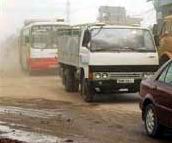Warning of Hanoi environment
The national forum for environmental health for 32 northern provinces has just been held in Hanoi, giving a deep warning about Hanoi's environmental health.
From solid waste polluting .

The ring roads all day are full of dust (Photo: vacne)
With about three million people, the city's solid waste amounts to hundreds of tons per day, but more notably, according to scientists, not only the amount of waste but also the amount of hazardous solid waste. Harmful, mainly industrial waste and medical waste in Hanoi ranked second in the country, only after Ho Chi Minh City, in terms of hazardous waste. If the volume of hazardous medical waste is distributed by location, only Hanoi and Ho Chi Minh City alone account for 35% of the country. On average, Hanoi city generates 59.3 tons of industrial waste and 1.65 tons of medical waste every day. Although some private companies have received hazardous waste treatment, due to limited capacity, the treatment has not met the environmental protection standards.
According to Dr. Tran Hong Ha, Director of the Department of Environmental Protection, if not properly planned and invested by central and local authorities, soon the hazardous waste will soon become a great challenge for Hanoi.
To surface water, groundwater pollution
As reflected by many readers, while Nhue River Day water is seriously polluted, some areas are polluted with heavy metal, the underground water source in Hanoi is also alarming. In addition, for many northern provinces, arsenic (arsenic) pollution in groundwater is becoming a major concern in people's lives. Nearly 70% of the upper water samples and nearly 50% of the lower water samples in Hanoi have dozens of arsenic concentrations higher than the permitted level.
Scientists warn that the use of drilled water in eating and drinking is at risk of arsenic poisoning, which in the long term may result in skin cancer, internal cancer and cardiovascular diseases. However, according to Mr. Nguyen Quy Hoa, UNICEF expert, arsenic is a substance that can be separated from water source in a not so difficult way. On a household scale, it is possible to build a filter using a number of available materials such as laterite, yellow sand, coal slag, rice husk, manganese iron reduction material .
The air is also heavily polluted!
Data from the Institute of Labor Medicine and Environmental Hygiene show that, in peak hours, Hanoi has dust concentrations four times higher than the permitted standard, CO is 2.5 to 4.4 times higher, slightly Gasoline from 12.1 to 2,000 times! Children of school age living around intersections are significantly affected by health: eyes, nose, throat, skin and nerves of plants are stimulated, the incidence of respiratory diseases is much higher. with the control group. At the locations of air monitoring stations such as Phung Hung Street, residential area of Ly Quoc Su Street (Hoan Kiem District), Nhu Quynh Industrial Zone, S02 gas concentration is significantly higher than the permitted standard.
In a recent survey of 1,500 Hanoi residents, it was found that more than 66% said that the air environment in Hanoi was heavily polluted and quite heavy, 32% considered " mild pollution ", only 2% said they could still "enjoy the fresh air".
Obviously, the above-mentioned numbers are " saying " one thing: Hanoi is facing many environmental challenges, there are many things to do to improve environmental quality, to contribute. Health protection for the people of the Capital.
- Early warning of dangerous hydrometeorological phenomena
- The air environment in Hanoi is declining
- Video: A rare film about Hanoi street 50 years ago
- Hanoi: VND 1,329 billion for environmental rescue
- Hanoi spent more than 3 billion VND for environmental planning
- Mexico invented cheap earthquake warning system
- Hanoi air pollution, the elderly and children should limit out
- Hanoi restricts the use of plastic bags
- Hanoi seeks to reduce air pollution
- Beam of images of 'black spots' on Hanoi 'lungs'
- Hanoi winter moments
- Vietnam will join the International Tsunami Warning System
 Is the magnetic North Pole shift dangerous to humanity?
Is the magnetic North Pole shift dangerous to humanity? Washington legalizes the recycling of human bodies into fertilizer
Washington legalizes the recycling of human bodies into fertilizer Lightning stone - the mysterious guest
Lightning stone - the mysterious guest Stunned by the mysterious sunset, strange appearance
Stunned by the mysterious sunset, strange appearance